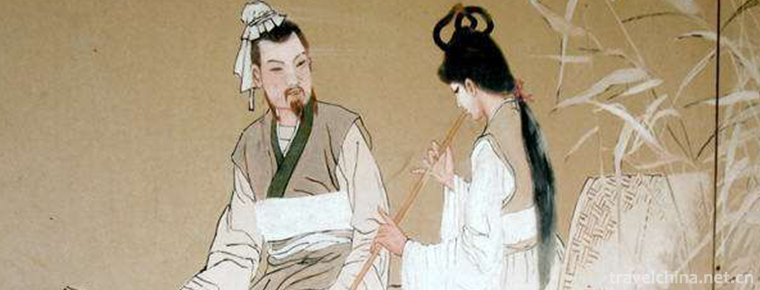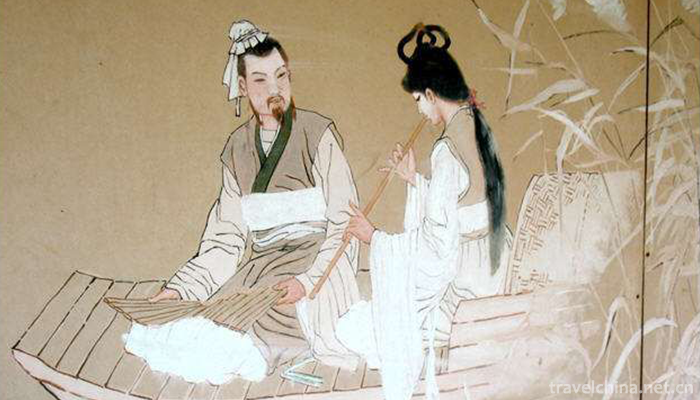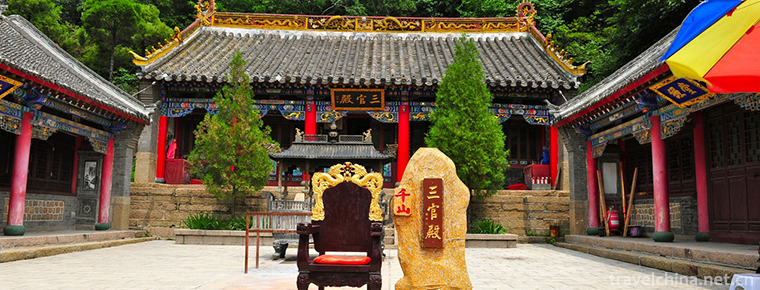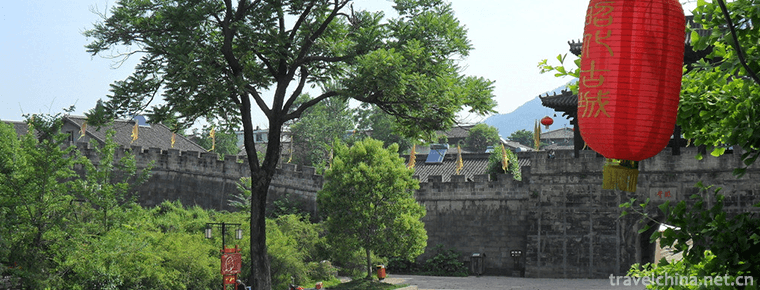2018-12-04

- By ChinaWiki.net
- Chinese Edition
- 2019-07-01
Legend of Xishi
Xishi legend, Zhejiang local folk literature, one of the national intangible cultural heritage.
Xishi is the first of the four beautiful women in ancient China. The legend about Xishi was born at the end of Spring and Autumn Period, and has been enriched ever since. Xishi legend takes the war between Wu and Yue as its historical background, takes Xishi's life-long legendary experience as its mainstay, takes various legendary categories as branches and leaves, and extols Xishi's beauty, kindness and dedication spirit of "willing to devote oneself to the country" from different angles.
On May 20, 2006, Xishi Legend was approved by the State Council of the People's Republic of China as the first batch of state-level intangible cultural heritage, non-legacy number I-10.
historical origin
In the fifth year of Duke Aigong of Lu (490 BC), Goujian, king of Yue, dedicated Xishi, Zheng Dan and other Chinese and American women to Wu Wangfuchao, hoping to confuse him with beauty and make him indulge in alcohol and ignore the dynasty. Xishi, with a national mission and a heavy burden of humiliation, plays a dual role of envoy and spy. In the 22nd year of Duke Aigong of Lu (473 B.C.), the army of Yue broke through Gusu, the capital of the State of Wu, and the State of Wu perished. Therefore, to a certain extent, the success of the restoration of Vietnam depends on Xishi's self-sacrifice and dedication. Therefore, Xishi's life was full of sorrow, twists and heavy. Folk legends about Xishi are beautiful and magical. They remain in people's minds. They are also the sacrifices made by Xishi for the restoration of Yue, which is why later generations praise and commemorate Xishi. The legend of Xishi was born in the late Spring and Autumn Period. It originated from the oral narrative of the people. The earliest relevant written records appeared in Mozi and Mencius. After recitation by people of all dynasties, it spread and became more colorful. There are many versions of Xishi's legend, which can be roughly divided into the following categories: the first one is the legend of characters. This kind of legend is the main content of Xishi legend. It is mainly based on many legends of Xishi's life, as well as a series of Legends of characters, such as "Dongshi Xiluan" and "the beauty of sinking fish". Most of these legends are extended around Xishi's life and destiny. They include both national enemies and family roots, and also narrate the love between men and women. The second is the legend of place names. The representative of this kind of legend is the well-known "White Fish Pool", and it is from this legend that the idiom "the beauty of sunk fish" comes into being. Third, customs and legends. This kind of legend is based on local customs, such as the "Sanjiangkou Water Lamp". It tells us that when Xishi entered the Wu Kingdom, the boat crossed the Sanjiangkou at night, the local villagers lit firewood and threw it into the river to illuminate the road for the beauty who "died for the country". In memory of Xishi, the water lamp was held every year. Activities. Until modern times, people still carry out the fourth kind of Water Lantern activities in the area of Zhuji Sanjiangkou in July and a half of the lunar calendar every year. The legend of products, such as the famous "Torreya Eye" comes from this legend.
Although Xishi legend has many kinds, it has one thing in common, that is, it praises Xishi's beauty, kindness and dedication from all angles, and also expresses people's respect for her spirit. The story of Xishi Legend has a long history, with nearly 2500 years of inheritance history. It is also very widespread, not only throughout Zhuji, but also across Jiangsu and Zhejiang provinces to all parts of the country, even as far as South Korea, Japan and Singapore and other Southeast Asian countries, regions and regions of Chinese people around the world. At the same time, the content of Xishi's legend is also very rich. The characters, place names, property and customs involved in it have covered almost all aspects of folk literature. In addition to folk communication, Xishi's legend has also been transmitted in various ways, such as drama, film and television programs.
Cultural characteristics
Content classification
The main contents of Xishi legend are as follows:
Character Legend: This category is the main content of Xishi Legend. Taking Xishi's legends as a branch, a series of Legends of characters emerged on this basis, such as Fan Li, Dongshi, Zheng Dan, Gou Jian, Wu Wangfuchao, Wu Zixu and others. Narrating Xishi's birth of "Pearl Beauty Fetus" and Wu's "Three Years to Send Xishi" are the most widely circulated articles in such legends.
Toponym legend: The most popular legend is "White Fish Pond", which evolved the beauty of sunken fish. This kind of legend includes "raccoon gauze stone", "Qianchi", "Four Eye Well", "Shiguping" and so on. As well as Shaoxing's "Tushan", Suzhou's "Playing with the Moon Pool", "Xiangbian Corridor", "One Arrow Jing" and many other articles.
Legend of Property: Many of Zhuji's specialties have legends related to Xishi, such as pearl, torreya, ramie, wheat straw fan, etc. The story of Xishi and Qiaoli is still circulated in Jiaxing.
Folklore legend: Taking "Sanjiangkou Water Lamp" as a representative, it tells the legend that Wu Zixu led the tide soldiers to Zhuji for revenge, and Zhuji people put water lanterns in Sanjiangkou to frighten the tide deity. To this day, seven. At the mouth of Sanjiangkou, Zhuji Diankou Town, there are still water lanterns, and folk proverbs that the tide is no more than Sanjiangkou. This kind of legend also includes Wangyuan wheat straw fan, Xishicai and so on.
artistic characteristics
Xishi legend has the characteristics of excellent folk literature, and the following four characteristics are more obvious:
The long history, it has more than 2500 years of inheritance history, from the Spring and Autumn Period to today;
The regional universality, which originated in Zhuji, radiated Jiangsu, Zhejiang and even the whole country, and even affected as far as overseas.
The richness of content, which involves almost all categories of folk literature, contains strong regional cultural characteristics.
The diversity of forms extends from oral transmission to performance forms such as rap and opera.
Inheritance
The legend of Xishi is passed down orally from generation to generation, and the involvement of some artists produces the form of singing communication. Before the 1960s, there were folk artists who spread Xishi stories in the countryside. They were often a person, a handful of Erhu, and Erhu was tied with gongs and cymbals. They sang Xishi legends by themselves, which were generally processed by themselves and relatively complete.
Manifestation
The legend of Xishi, like the general oral literature, is more casual in location and manner, and is generally spread in the way of telling stories in the leisure time of agriculture.
The legend of Xishi is a casual expression of folk spontaneous narration and oral transmission. Generally, props are not used and different gestures, movements and tones are added.
Inheritance and Protection
Inheritance value
The legend of Xishi has other important values besides the disciplinary significance of folk literature and art itself.
Literary Value: Legend, as a popular literary reading material, has been widely circulated, young and old, and has always been the source of creation of various literary styles. Literary works with Xishi legend as the subject matter are varied. At the same time, through the dissemination of literary forms, the influence of "Xishi legend" has been expanded and the content of the legend has been enriched. Studying the relationship between them is of great significance to the prosperity of literature and art.
Aesthetic value: Xishi, as an aesthetic symbol, occupies a unique position in the history of Chinese aesthetics and deserves further study from the perspective of aesthetics.
Cognitive value and historiographic value: Xishi legend was born from the war between Wu and Yue. It is a folk interpretation of the history and culture of ancient Wu and Yue, and has important reference value for the study of the history of Spring and Autumn Period.
Humanistic value: Legend praises truth, goodness and beauty, advocates heroism and devotion spirit, which is of positive significance to the promotion of excellent humanistic spirit.
protective measures
In 1981, the Chinese Folk Literature and Art Publishing House published the series "Stories of Xishi" in Shanhai Jing. Xishi's stories and legends became an important part of folk literature.
In 2003, the Culture and History Committee of Zhuji Municipal Consultative Conference published "Search for Xishi" to further publicize Xishi culture.
Since the 21st century, in order to disseminate Xishi culture, Zhuji City has attached great importance to the popularization of Xishi culture among ordinary citizens, especially young people, and carried out a number of activities. First of all, send "Xishi" to the campus and implant the seeds of culture into the hearts of teenagers. Teenagers are the hope of Zhuji's future and the inheritor of Zhuji's culture. Their recognition and understanding of Xishi culture is directly related to the future development of Xishi culture. In order to popularize Xi Shi culture among students, the Municipal Cultural Department recompiled the popular reading of "Xi Shi legend" which is suitable for students to read. It also introduced the essence of Xi Shi's legend and the education department together, and formulated the local teaching materials in Zhuji. It introduced the Xi Shi culture of Zhuji in a long way, and opened "interest stories of Xi Shi stories" among young people to carry out the biography contest. To cultivate inheritors.
social influence
Important activities
In May 2017, Shaoxing Teacher's Story-telling Competition was held in Bowen Campus of Binjiang Primary School. During the competition, adults and children from all parts of the city took intangible cultural heritage as the main theme, and combined with the characters in Shaoxing's folk stories, they created and narrated Xu Wenchang's Bridge Selling, Wang Xizhi's Legend and Liang Zhu's Legend.《 The legend of Xishi, the legend of Liu Ruan, the legend of Yu Shun, Wang Huizu, the famous curtain of a generation, the legend of returning flesh to mother, the legend of Shaoxing mouldy tofu and other stories.

Ask a Question
Your email address will not be published.



0 Questions